Introduction
- Venice is a city in Italy;
- 55,000 people live in Venice, but the number does not include Comune di Venezia (Buckley, 2020);
- The surface area of the city is 5 km2 (Momigliano, 2020);
- Venice is a massively popular tourist destination (Toro et al., 2019).
Venice is among the most popular tourist destinations in the world. The historic city is relatively small, with a population of 55,000 (which keeps falling) in an area of five square kilometers, though the surrounding Comune di Venezia, which is the city’s municipality, is substantially larger and has more population (Buckley, 2020; Momigliano, 2020). According to Momigliano (2020), this figure means that Venice should no longer be conventionally considered a city in Italy. There are several reasons for the city’s declining population size, one of which is its popularity as a tourist destination. However, in this presentation, the authors will explore the environmental issues of Venice and the solutions that are being implemented.
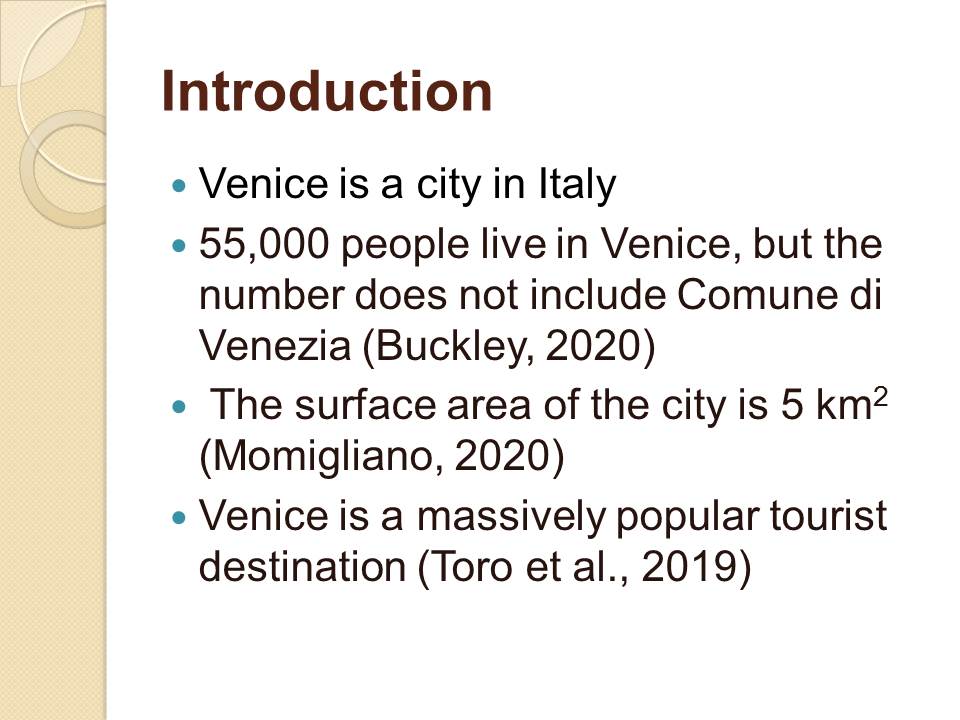
Analysis: Social Issues
- Excessive tourist traffic strains systems (Fletcher et al., 2020);
- Population capacity limit exceeded, over 20 million visitors a year (Fletcher et al., 2020);
- Attempted solutions were ineffective and met with resistance from residents (Visentin & Bertocchi, 2019).
The massive tourist influx into the city generates revenues, but it also harms the local infrastructure. Over 20 million people visit the city annually, mostly focusing on the city and its historical buildings rather than the Comune (Fletcher et al., 2020). As a result, congestion issues are prevalent, real estate prices are rising, and crime rates are increasing. Venice’s government has tried to block large cruise ships, limit visitor numbers, and introduce tourism taxes, but these moves have been controversial and met with resistance (Visentin & Bertocchi, 2019).
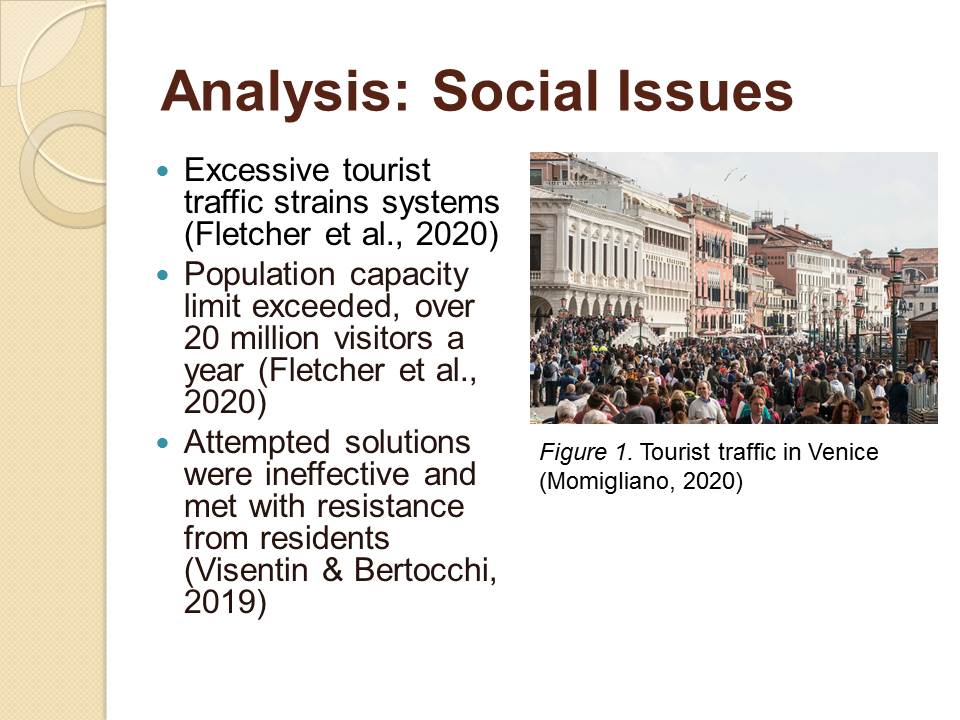
Analysis: Environmental Issues
- Water levels in Venice are rising;
- The floods are damaging buildings and submerging areas (Hollingsworth, 2019);
- A $14 billion project named MOSE is aimed at protecting Venice (Johansen, 2017);
- However, it exacerbates pollution concerns (Tinger & Titlow, 2016).
Due to a combination of the city’s sinking and climate change increasing water levels, Venice is becoming increasingly prone to damaging floods (Crume, 2016). To address it, the city introduced a $1 billion “project known as MOSE (Modulo Sperimentale Elettromeccanico, or Experimental Electromechanical Module)” in 2003, but the costs eventually escalated to $14 billion (Johansen, 2017, p. 292). It was nearing completion in 2016, with the barriers that are integral to the project being nearly constructed entirely (Johansen, 2017). However, water near Venice is already somewhat polluted, and the impediment to currents that MOSE presents can contribute to an escalation of the issue (Johansen, 2017).

The Flooding of Venice
- Venice has been sinking for the last millennium (Gaskin-Reyes, 2016);
- The city is not over any single landmass (Tinger & Titlow, 2016);
- Global warming is increasing sea levels (Crume, 2019);
- Venice’s art and architecture are eroding (Crume, 2019).
Venice was built without modern knowledge, which would have prevented its construction over an archipelago and gave it the distinction of being a water city (Tinger & Titlow, 2016). As a result, it has been sinking nearly since the time of its original founding (Gaskin-Reyes, 2016). The problem is particularly prevalent nowadays because of the rising sea levels, which also contribute to the flooding (Crume, 2019). In addition to the disruptions that the flooding of public and private spaces creates, the water also damages Venice’s art and architecture, which are essential to its rich historical heritage.
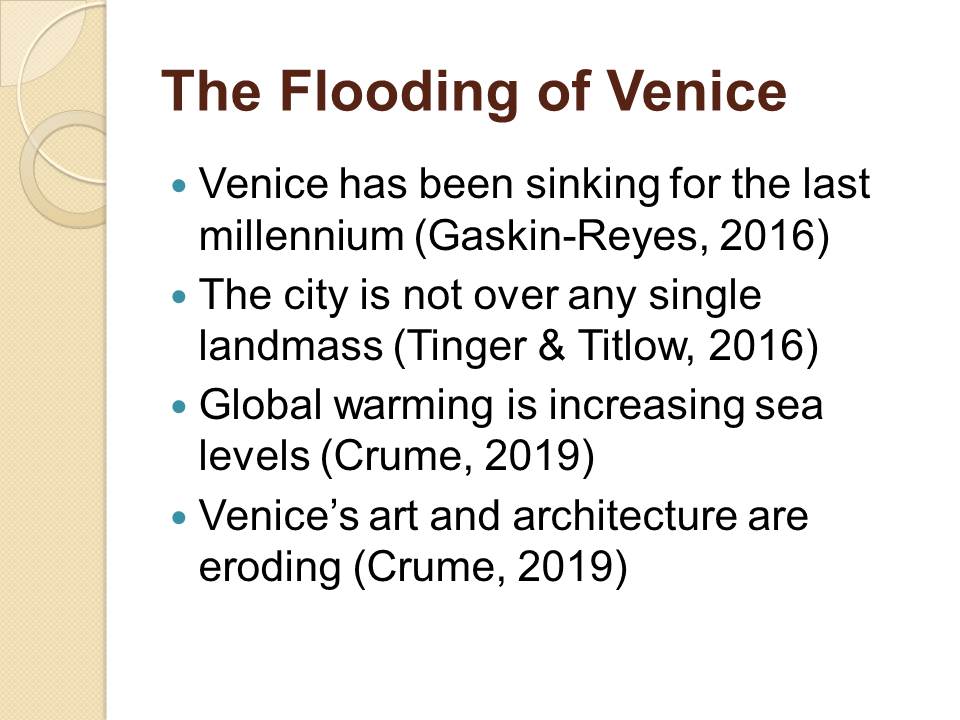
The MOSE System
- Named after Moses and the parting of the Red Sea (Wolf, 2019);
- Aimed at controlling the influx of water into the Lagoon of Venice (Wolf, 2019);
- Cost initially estimated at $1 billion (Johansen, 2017);
- Eventually increased to $14 billion (Johansen, 2017).
The MOSE system, which is a reference to Biblical Moses and means “Experimental Electromechanical Module,” was proposed in 2003 (Crume, 2019). Its purpose is to prevent the influx of water to the Lagoon of Venice in case of flooding via the blockage of water inlets (Tinger & Titlow, 2016). While it was initially estimated at the cost of $1 billion, in 2013, the expenses amounted to $14 billion (Johansen, 2017). There has been a substantial amount of corruption associated with the project, and arrests on charges of bribery and bid-rigging include the former mayor of Venice (Crume, 2019).
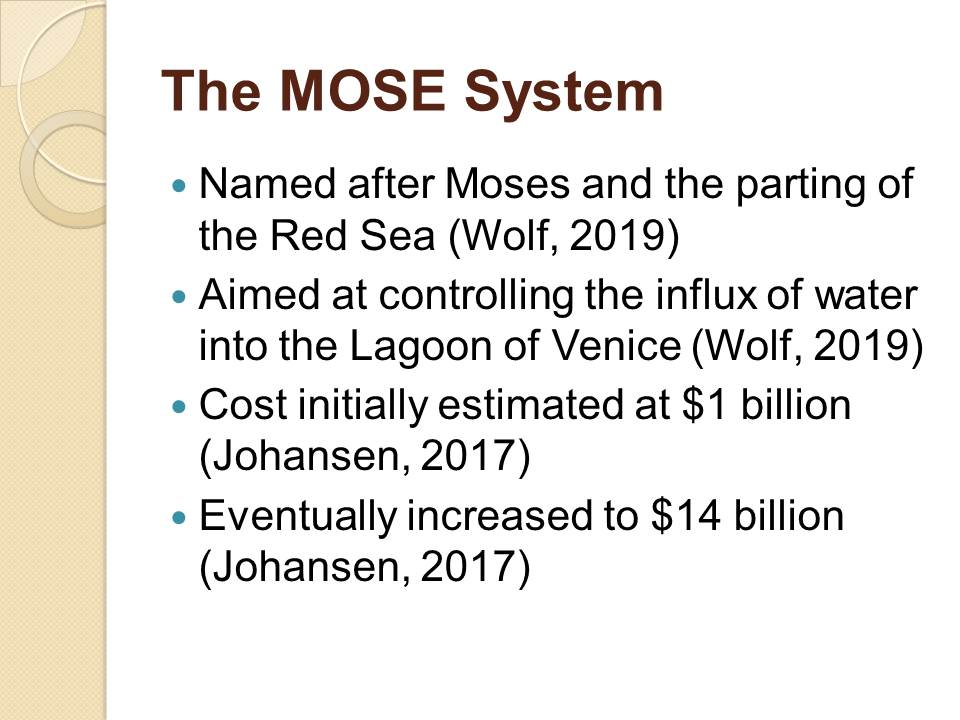
The Structure of the MOSE System
- Positioned at each of the three inlets;
- A total of 78 independent gates (Gaskin-Reyes, 2016);
- Raised when flooding exceeds 3.6 feet (Tinger & Titlow, 2016).
There are three inlets from the Adriatic Sea to the Lagoon of Venice: Lido, Malamocco, and Chioggia (Wolf, 2017). Per Gaskin-Reyes (2016), there will be a total of 78 gates installed in these three inlets to prevent the inflow of water once flooding reaches 3.6 feet. In Fig. 3, which depicts an individual gate in a disabled configuration, 1 is the gate, 2 is the hinge that controls it, 3 is the interior of the construction, 4 is the empty region, and 5 is the ballast that keeps the gate in place. In the event of flooding, water is pumped from region 1 to region 4, and the now-hollow gate is raised, separating the mare (sea) from the laguna (lagoon) (Wolf, 2017).
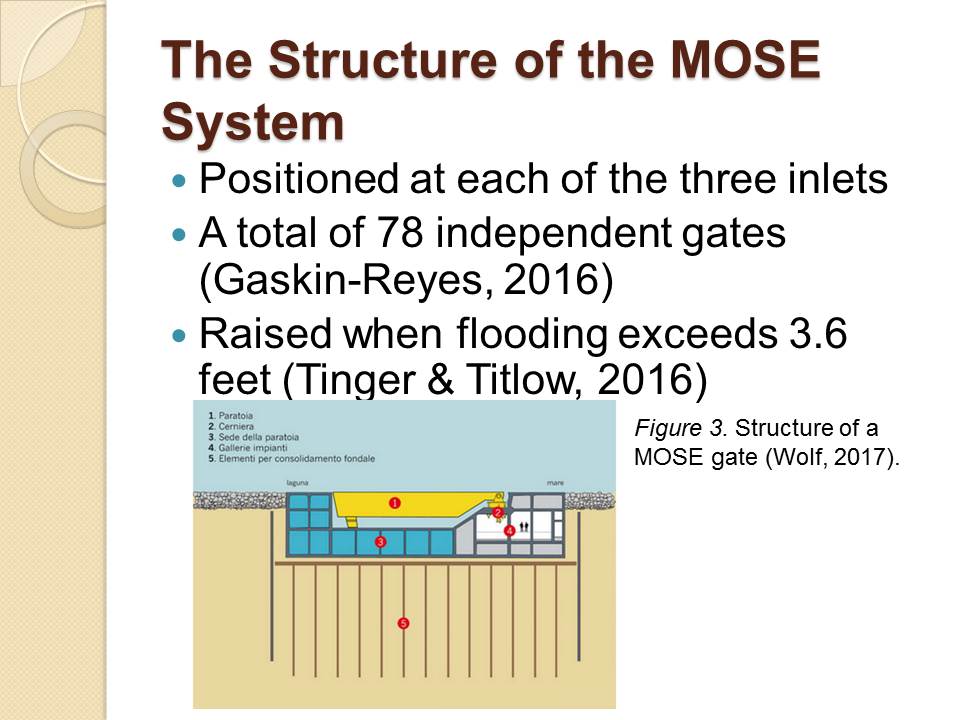
The Issues of MOSE
- Limited term of use;
- Traps pollution within the lagoon;
- Does not address the city’s sinking.
There are several practical issues in addition to the cost and the numerous delays that lower MOSE’s attractiveness. The first is its eventual obsolescence due to rising sea levels, which may render it useless within 30 years rather than the projected 50 (Crume, 2019). Another frequently voiced concern is the stoppage of currents, which would trap Venice’s sewage, which is not treated, within the lagoon (Tinger & Titlow, 2016). Lastly, while MOSE can help slow down the effects of the increasing sea levels, it does not affect Venice’s continued sinking.
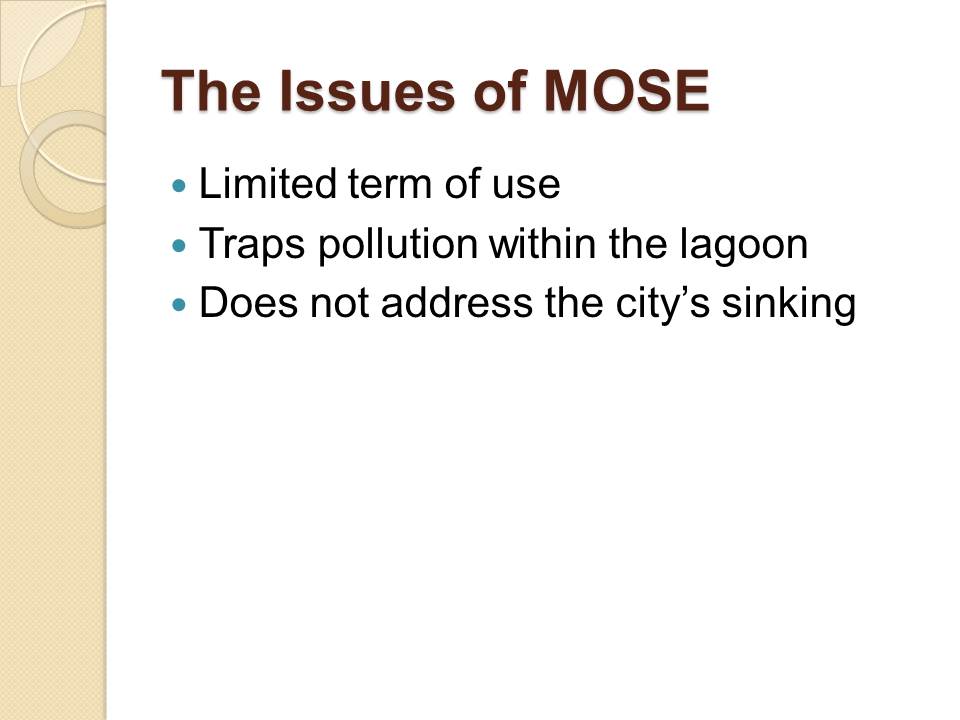
Pollution in Venice
- No sewage treatment system;
- Industry, motor traffic, and human waste in the area;
- The port emits pollution (Wood, 2017);
- Inadequate canal cleaning (Gaskin-Reyes, 2016).
Venice currently has a noteworthy pollution problem, which may be exacerbated to a dangerous degree by the creation of the MOSE. The city does not have the capacity to treat waste using modern methods and relies on it dissipating into the Adriatic Sea via the inlets (Tinger & Titlow, 2016). Meanwhile, there are several substantial sources of pollution in the region, including the human waste from the population and tourists, industry and motor traffic created by the tourism (Johansen, 2017), and the presence of a port that admits increasingly large ships with the associated harms (Wood, 2017). Some critics also highlight the inadequate canal cleaning, which enables waste to accumulate in them and may be partially responsible for the flooding in the city (Gaskin-Reyes, 2016).
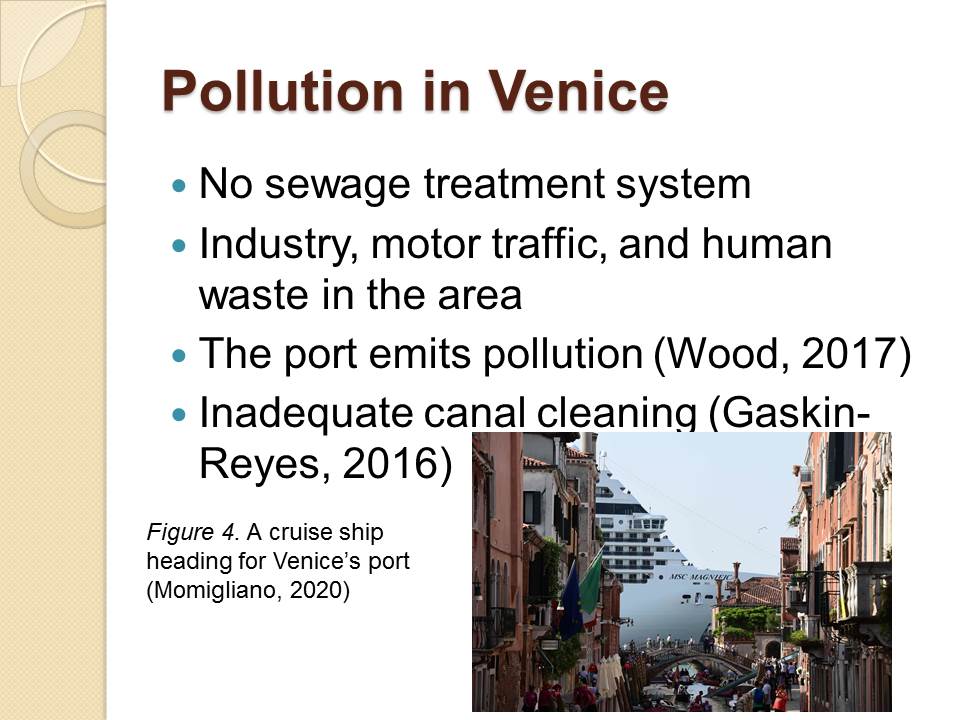
Answers to Pollution
- Treatment plant construction;
- Portside electrical power system (Wood, 2017);
- Dredging and disposal of sediment.
At the moment, Venice’s efforts to address pollution are mostly focused on the port and the ecosystem damage that it is causing. It has invested 15 million Euros into a plant that prevents polluted waste from entering the waterways, and banks have been made watertight to avoid contamination (Wood, 2017). In an effort to enable ships to shut off their engines while in port and avoid the resulting discharges, the port has introduced an effort to develop a power system that can supplement their needs instead (Wood, 2017). Lastly, the city has invested in the removal and disposal of over 80,000 cubic meters of sediment, which required an investment of 700 million Euros. As a result, the port has been made accessible to larger ships, and the polluted substances at the bottom of the lagoon have been removed.
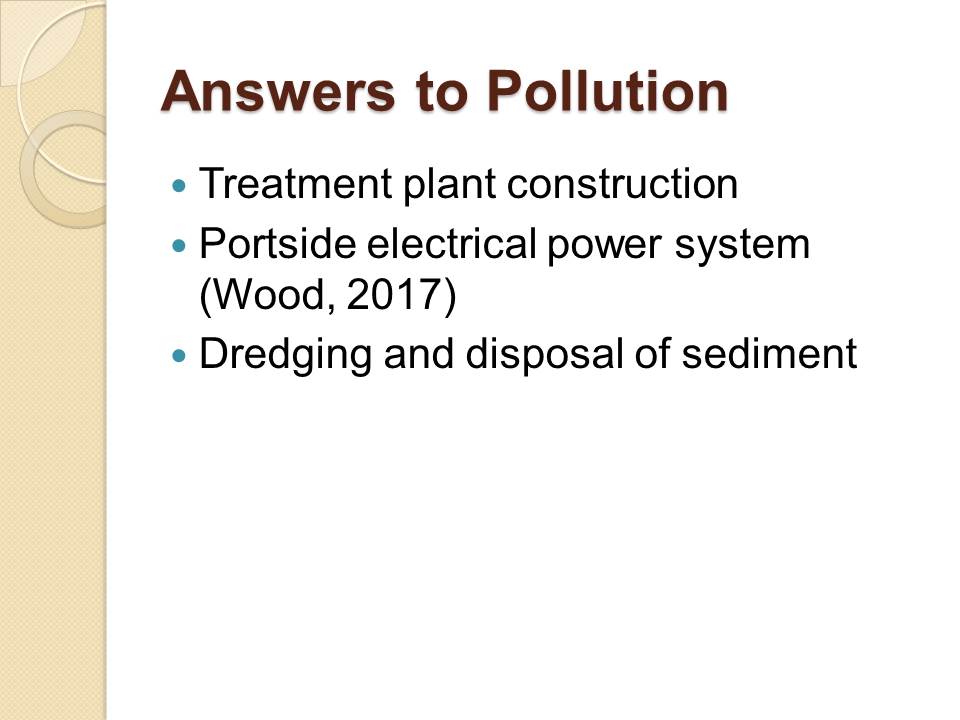
Conclusion
- Venice’s existence is threatened by flooding;
- The usefulness of the current solution is debatable;
- Pollution is an emerging issue;
- Efforts to address it may be misplaced.
Due to the continued sinking of Venice and the rise in sea levels, the city may eventually flood permanently. Such an event would destroy priceless cultural heritage for humanity and has to be addressed. With that said, the current solution, MOSE, is associated with a variety of issues, including cost, delays, and limited effectiveness. Moreover, it can exacerbate the problem of pollution, which is currently emerging in Venice. The city is trying to address one of the sources, namely the port, but the city has been the subject of less focus. As a result, it is possible that the issues associated with water flow stagnation develop unchecked until they become severe, at which point it will be too late to react.
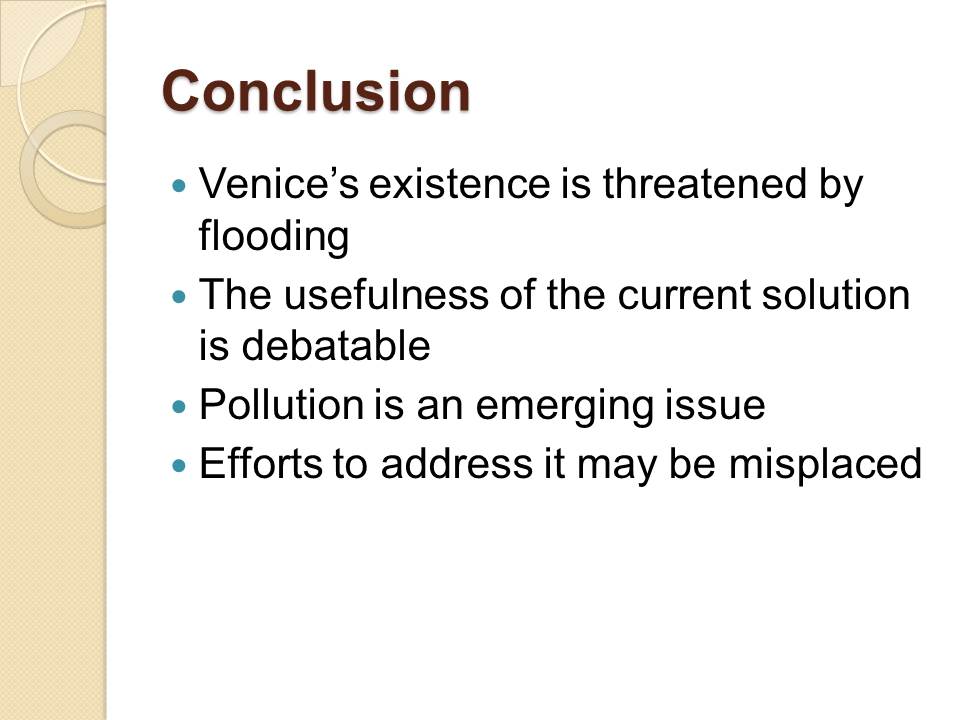
References
Buckley, J. (2020). Is Venice at war with itself? CNN Travel. Web.
Crume, R. V. (2019). Urban health issues: Exploring the impacts of big-city living. ABC-CLIO.
Hollingsworth, J. (2019). Worst floods for 50 years bring Venice to ‘its knees.’ CNN. Web.
Gaskin-Reyes, C. (Ed.). (2016). Water planet: The culture, politics, economics, and sustainability of water on Earth. ABC-CLIO.
Johansen, B. E. (2017). Climate change: An encyclopedia of science, society, and solutions. ABC-CLIO.
Momigliano, A. (2020, July 2). Venice tourism may never be the same. It could be better. The New York Times. Web.
Tinger, M., & Titlow, B. (2016). Protecting the planet: Environmental champions from conservation to climate change. Prometheus Books.
Toro, P. D., Forte, B., & Cerreta, M. (2019). The human sustainable city: Challenges and perspectives from the habitat agenda. Taylor & Francis.
Visentin, F., & Bertocchi, D. (2019). Venice: An analysis of tourism excesses in an overtourism icon. In C. Milano, J. M. Cheer, & M. Novelli, (Eds.), Overtourism: Excesses, discontents and measures in travel and tourism (pp. 18-38). CABI.
Wanhill, S., Gilbert, D., Fletcher, J., & Fyall, A. (2017). Tourism: Principles and practice. Pearson Education Limited.
Wolf, E. (2019). Can physics save Miami (and Shanghai and Venice, by lowering the sea)? Morgan & Claypool Publishers.
Wood, M. E. (2017). Sustainable tourism on a finite planet: Environmental, business and policy solutions. Taylor & Francis.